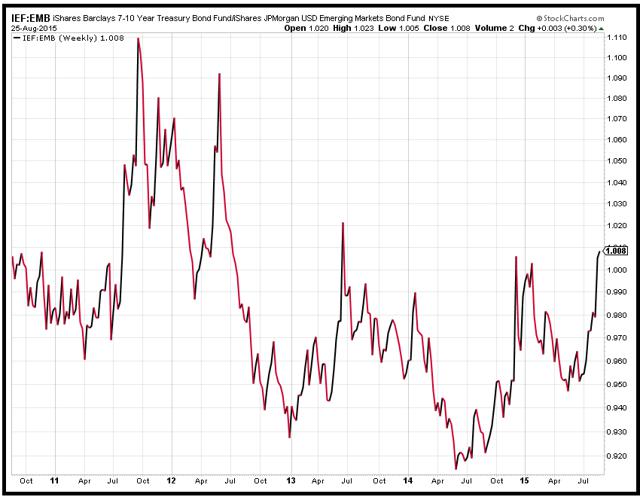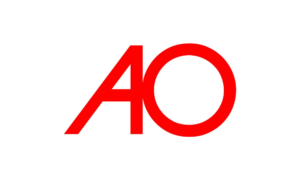Fra Seeking alpha
Summary
- Bond yield spreads are signaling further equity market selling in coming months.
- Junk bonds and emerging market debt are being sold heavily, signaling deteriorating risk sentiment.
- Gaining exposure to the short side of the market may be the best tactical option for one’s portfolio.
The drastic global market selloff this week has spooked investors, and taken equity indexes into negative territory for the year. Many pundits are debating the validity of the pullback, and by looking at credit markets, it seems as if heightened volatility could stick around for a while.
Yield spreads measure the difference between bond instruments, taking into account either maturity or risk level of the differing bonds. The spread shown below takes into account junk bond yields and the risk-free treasury rate, both products having similar maturity dates. The actual ratio looks at iShares Barclays 7-10 Year Treasury (NYSEARCA:IEF) over SPDR Barclays High Yield Bond (NYSEARCA:JNK). When the indicator rises it signals the spread is widening, and when it falls the spread contracts.
Conventional rationale says that when investors are cautious, they will prefer safer Treasuries to junk bonds, and thus the spread will expand. This week, during the peak of the selloff, the junk yield spread expanded to its highest level since 2012. Moreover, the spread has expanded over the last year as upward momentum in equity markets slowed. This is a troubling sign, but by itself it does not foretell further equity selling pressure.
Additionally, emerging markets have seen selling off in their assets in recent weeks as investors sold off riskier holdings. China was the root cause for most of the selling as its manufacturing sector further slowed and its currency devaluation made emerging currencies relatively more expensive.
Industrial production in China declined to a 6% annual pace in July, its slowest pace in the last decade. This has weighed on commodity prices, which has been a large reason for the global deflationary cycle. With regards to its currency devaluation, many emerging countries compete with China for exports, and when the yuan falls, it makes their currencies relatively more expensive. This will potentially weigh on emerging countries’ economic growth in coming quarters.
Below is a chart of the iShares Barclays 7-10 Year Treasury over the iShares J.P. Morgan USD Emerging Markets Bond (NYSEARCA:EMB). When the indicator rises, it signals emerging market yield spreads are expanding. Over the last few months as emerging market equities declined, the spread has greatly expanded to multi-year highs, foreshadowing further volatility in emerging market assets.
The final chart is of the U.S. intermediate yield spread. It takes into account the expectation for a rate rise in coming months. When the indicator declines, it signals the spread is tightening and investors foresee a longer period of time before the Federal Reserve begins tightening monetary policy. The actual underlying assets are the iShares Barclays 1-3 Year Treasury Bond(NYSEARCA:SHY) over the iShares Barclays 7-10 Year Treasury.
A few notable occurrences on the chart below are in 2011 and 2012 when the Fed initiated further rounds of quantitative easing, the spread drastically fell lower. Then in May 2013, when Ben Bernanke hinted at ending stimulus measures, the indicator spiked higher, then fell lower in 2014 when Janet Yellen came into office and it was realized rates would not immediately be raised. In recent months, the spread has again contracted as investors price in a later date of initial Fed tightening due to the confluence of global factors weighing on growth and inflation.
What can be made of all of this?
These charts each tell a unique story, but influence the trend of overall global markets. Junk bond spreads contract when the market is operating smoothly, but due to the rapid expansion in recent weeks, it is clear equity investors may not be as willing to “buy the dips” this time around. Moreover, emerging markets are feeling the pain of lower commodity prices and increased competition from China, with its loose monetary policy and currency devaluation.
With emerging markets weakening, it puts the onus of global growth on the shoulders of developed countries. Furthermore, the Treasury yield spread in the U.S. is contracting, signaling a pessimistic view of future growth and inflation expectations, as well as a diminishing chance that the Fed tightens policy in coming months.
How is it that an investor can profit then with bonds, equities, commodities, and just about everything else selling off? My answer has been to move my clients’ money into inverse ETFs and hedge current positions with put options contracts. The derivative contracts may not be for everyone, but an inverse ETF can hedge a portfolio nicely. The two products I like are the ProShares Short S&P 500 (NYSEARCA:SH) and the ProShares UltraShort S&P 500(NYSEARCA:SDS).
The UltraShort is leveraged 200%, and should be handled accordingly because of the added volatility. The normal short fund, however, provides negative delta, and is a much better alternative to holding the iPath S&P 500 VIX ST Futures ETN (NYSEARCA:VXX), or any other pure volatility tracking fund. The times ahead could be tough, but with the ability to get short exposure, or simply hedge your portfolio with some negative delta, tensions may be somewhat alleviated

















